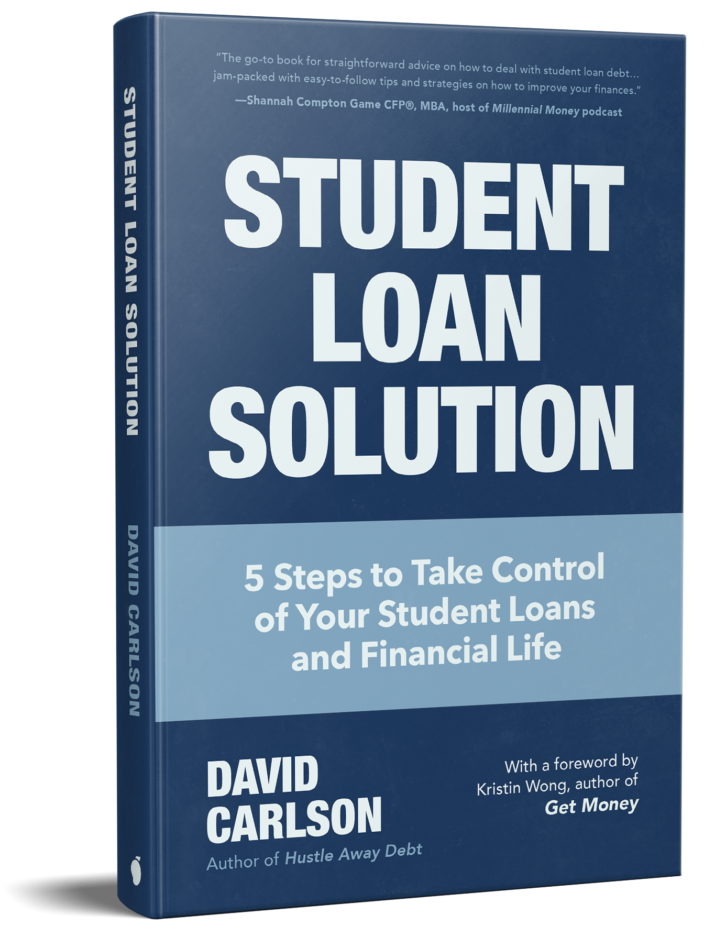 Based on content from the book Student Loan Solution: 5 Steps to Take Control of your Student Loans and Financial Life.
Based on content from the book Student Loan Solution: 5 Steps to Take Control of your Student Loans and Financial Life.
Over one million new borrowers default on federal student loans each year, and according to a January 2018 report published by the Brookings Institution, nearly 40 percent of student loan borrowers may default on their student loans by 2023.
Remember, the one million new borrowers a year is just new borrowers who go into default, not the ones that were already in default.
You get the point, a lot of people are behind on their student loan payments. If you are one of them, it’s nice to know you aren’t the only one, but you probably are wondering “what about my situation? What am I supposed to do?”
Despite the unfortunate fact that student loans are extremely difficult to discharge in bankruptcy, you do have options. Your first goal should be to get your loans “current,” or in other words, make your loan payments up-to-date and no longer behind. The second goal is to get set up on an income-driven repayment plan that makes your monthly minimum required loan payment affordable.
Note: This post is focused on federal student loans, not loans from a private lender (for example if you refinanced your federal loans through a bank or took out private loans during undergrad or grad school). If you are behind on those loans, the best thing you can do is speak with your lender. See what sort of affordable payment plan can be set up. If you get nowhere or feel harassed/intimidated by the lender or collections agency consider filing a complaint with the Consumer Financial Protection Bureau.
First of all, what does it mean to default on your student loans? For most federal student loans, you will default if you don’t make a payment in more than 270 days. Officially entering default usually doesn’t actually happen until 360 days, though, as lenders have 90 days to file a default claim and most wait until the end of that 90-day claim period to file.
The general steps in default are:
- You haven’t made a payment for more than 270 days, triggering the 90-day period for lenders to file a default claim.
- Once the claim is filed, the entire balance, both principal and interest, become immediately due.
- You lose access to options like deferment, forbearance, and repayment plans.
- You either make repayment arrangements with the holder of your loan or your loan gets placed with a collection agency.
- The collection agency will offer the option of a voluntary repayment agreement.
- If you don’t enter into the voluntary repayment agreement, or fail to make the agreed payments, the collection agency will take actions such as wage garnishment. If you are self-employed and they cannot garnish your wages through an employer, the U.S. Department of Justice may take legal action – by suing you – to collect on the defaulted loans.
The first thing you need to determine is if you are in default or simply behind on your student loans. If you are less than 270 days behind on your loans you are not in default. If you are more than 270 but less than 360 days behind, you could be in default but likely are not in default unless you are closer to the 360 than 270 days behind. Finally if you are more than 360 days behind you are almost certainly in default.
Let’s first look at what you can do if you are behind on your loans but have not yet gone into default.
If You Are Behind But Have Not Defaulted Yet
If you are behind on your loans but haven’t defaulted yet you are in delinquency, in other words “behind on your loans.” If you fall into this category it’s important to get out of default ASAP. Two ways to do this are:
- Pay Your Missed Payments – Paying your missed payments will make your loans current, meaning, you are no longer behind on student loan payments. This of course is unrealistic for many or they wouldn’t have missed payments in the first place.
- Enter Forbearance or Deferment – If your loan servicer(s) grant you forbearance or deferment your loans will be made current, primarily because the 270 day period of missed payments does not count time spent in deferment or forbearance. Deferment is preferable to forbearance, as federal subsidized student loans do not accrue interest while in deferment, but they do while in forbearance. Forbearance is easier to get granted, though, and you may need to go this route if you aren’t eligible for deferment.
Avoiding default is ideal, but you may already be in default. Let’s go over your options if that’s the case.
If You Are In Default
If you are already in default, there’s a couple of different options you can choose from to get out of default.
Option #1: Loan Rehabilitation
Loan rehabilitation is one way to get out of default. The process starts by contacting your loan holder. Rehabilitation will make your loans current once you make nine payments during a period of ten consecutive months.
The payments are determined between you and your loan holder. These payments are deemed “reasonable” based on your financial situation. How this is determined is by taking 15% of your annual discretionary income, divided by twelve. Discretionary income is your income above and beyond 150% of the federal poverty level. This is similar to income-driven repayment plans, which I will discuss shortly, and ultimately should be a reasonably affordable payment.
Note that fees of up to 16% of the value of your loans may be charged for loan rehabilitation, which is unfortunate as it just makes what likely was already relatively large student loan balance even larger.
Option #2: Loan Consolidation
The other option for getting out of default is loan consolidation. Consolidating your loans allows you to quickly make your defaulted loans current. There are no required payments you have to make.
Loan consolidation, like loan rehabilitation, can include fees being added to the balance of your student loans. In the case of loan consolidation, you could see fees of up to 18.5%. It also could be worse for your credit score since the record of the defaulted loans will stay on your credit history for seven years; this is not the case with loan rehabilitation.
With loan consolidation you must enter an income-driven repayment plan unless you make three voluntary, on-time, full monthly payments on the defaulted loans prior to consolidation. These payments will be determined by your loan holder, but must be reasonable and affordable for your financial situation. If you make these payments, you will be able to choose any repayment plan available.
Next Step: Get On An Income-Driven Repayment Plan
Once you have either made your loans current and/or exited default, it’s important to avoid falling behind again. The best way to do this is through an income-driven repayment plan.
An income-driven repayment plan works exactly how it sounds: your monthly student loan payments are capped as a percentage of your income. There are four different income-driven repayment plans, each with their own pros and cons. They include:
- Pay As You Earn (PAYE)
- Revised Pay As You Earn (REPAYE)
- Income-Based Repayment (IBR)
- Income-Contingent Repayment (ICR)
Here’s a brief overview of income-driven repayment plans.

